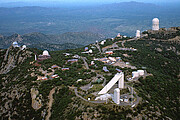Kitt Peak National Observatory Celebrates 40 Years of Discovery: 1958 - 1998
24 September 1998
October of 1998 marks the 40th anniversary of the founding of Kitt Peak National Observatory (KPNO), the first astronomy observatory in the U.S. available to all qualified astronomers regardless of institutional affiliation. Kitt Peak today is home to the world's largest collection of optical telescopes, under skies which continue to be some of the finest in the world for astronomical observations. Historical images and information on the excellence of scientific research at Kitt Peak can be found through a link on the KPNO Home Page at http://www.noao.edu/kpno/40th/.
It was in October of 1958 that the Tohono O'odham Nation (then known as the Papago Tribe) signed an agreement with the National Science Foundation and the Association of Universities for Research in Astronomy (AURA) Inc., and Kitt Peak National Observatory was established. Kitt Peak, located in the Quinlan Mountains of the Sonoran Desert, comprises 200 acres of the nearly 3 million acre Tohono O'odham Nation. This land is leased under a perpetual agreement that is valid for as long as scientific research facilities are maintained at the site.
In 1984, the National Optical Astronomy Observatories (NOAO) was formed, consolidating management of the three national groundbased optical observatories: Kitt Peak National Observatory, the National Solar Observatory with facilities at Kitt Peak and Sacramento Peak, New Mexico, and the Cerro Tololo Inter-American Observatory in Chile. NOAO also represents the U.S. astronomical community in the International Gemini Observatory, with twin 8-meter telescopes currently under construction in Hawaii and Chile. Headquarters for NOAO are in Tucson, Arizona.
Today, KPNO offers state of the art observing facilities on five nighttime telescopes. In addition, the National Solar Observatory maintains telescopes on Kitt Peak for studying and monitoring the Sun that are unique in the world. Last year, more than 500 astronomers from around the country and the world traveled to Kitt Peak to carry out their observing programs at NOAO facilities.
NOAO telescopes on Kitt Peak have made major contributions to our understanding of the universe. The Mayall 4-meter has played an important role in establishing the existence of dark matter through observations of the rotation curves of galaxies, in determinations of stellar radii from lunar occultations, and in our understanding of the cosmological distance scale and large scale structure of the universe. The 2.1-meter telescope made the first observations of the "Lyman-alpha forest," a characteristic absorption pattern arising from the element hydrogen that provides important clues to conditions in the early universe. The smaller telescopes on Kitt Peak have also made significant contributions, such as establishing standards for measuring the brightness of stars, in systematic studies of star formation, and in surveys of clusters of galaxies, planetary nebulae, and star forming regions. Understanding of the major issues in astronomy rarely comes as a sudden burst of illumination. Instead our knowledge of the universe can be likened to the assembly of a giant mosaic, many pieces of which have been defined by telescopes on Kitt Peak.
While taking pride in accomplishments of the last 40 years, Kitt Peak is constantly renewing its facilities to meet the needs of forefront astronomy. Some examples of this renewal follow:
- Large glass photographic plates prevalent 40 years ago have been replaced by digital detectors capable of the same wide field of view with vastly greater sensitivity and color range.
- Facilities for daily observations of the Sun, which take place at the National Solar Observatory Kitt Peak Vacuum Telescope, are being replaced with a recently funded project called SOLIS, which provides automated, cost-effective daily observations with immediate release of data to scientists and to the public.
- The newest major telescope on Kitt Peak, the 3.5-meter Wisconsin-Indiana-Yale-NOAO "WIYN" telescope, produces extremely sharp images because of its design based on new technology. WIYN represents a new era of building national facilities in partnership with universities. Dedicated in 1994, WIYN has already been credited with discovering supernovae in distant galaxies and determining optical counterparts to gamma ray bursters.
"Forty years of discovery have revolutionized our view of the Universe," said Kitt Peak National Observatory Director, Dr. Richard Green, "and Kitt Peak looks to the new millennium with excitement at the prospects of continuing to advance the frontiers of astronomical knowledge."
Notes
The mission of NOAO is to provide leadership in the establishment and operation of premier groundbased astronomical research facilities, to promote public understanding and support of science, and to advance all aspects of US groundbased astronomical research. NOAO is operated by the Association of Universities for Research in Astronomy, an Arizona non-profit corporation, under cooperative agreement with the National Science Foundation.
Editors: This press release, including a high-resolution version of the image, is available electronically over the Internet via http://www.noao.edu/
The National Optical Astronomy Observatories are operated by the Association of Universities for Research in Astronomy (AURA), Inc., under Cooperative Agreement with the National Science Foundation.



